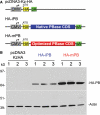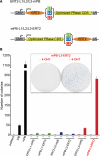Generation of an inducible and optimized piggyBac transposon system
- PMID: 17576687
- PMCID: PMC1919496
- DOI: 10.1093/nar/gkm446
Generation of an inducible and optimized piggyBac transposon system
Abstract
Genomic studies in the mouse have been slowed by the lack of transposon-mediated mutagenesis. However, since the resurrection of Sleeping Beauty (SB), the possibility of performing forward genetics in mice has been reinforced. Recently, piggyBac (PB), a functional transposon from insects, was also described to work in mammals. As the activity of PB is higher than that of SB11 and SB12, two hyperactive SB transposases, we have characterized and improved the PB system in mouse ES cells. We have generated a mouse codon-optimized version of the PB transposase coding sequence (CDS) which provides transposition levels greater than the original. We have also found that the promoter sequence predicted in the 5'-terminal repeat of the PB transposon is active in the mammalian context. Finally, we have engineered inducible versions of the optimized piggyBac transposase fused with ERT2. One of them, when induced, provides higher levels of transposition than the native piggyBac CDS, whereas in the absence of induction its activity is indistinguishable from background. We expect that these tools, adaptable to perform mouse-germline mutagenesis, will facilitate the identification of genes involved in pathological and physiological processes, such as cancer or ES cell differentiation.
Figures




References
-
- Carlson CM, Largaespada DA. Insertional mutagenesis in mice: new perspectives and tools. Nat. Rev. Genet. 2005;6:568–580. - PubMed
-
- Ivics Z, Hackett PB, Plasterk RH, Izsvak Z. Molecular reconstruction of Sleeping Beauty, a Tc1-like transposon from fish, and its transposition in human cells. Cell. 1997;91:501–510. - PubMed
Publication types
MeSH terms
Substances
Grants and funding
LinkOut - more resources
Full Text Sources
Other Literature Sources
Research Materials

